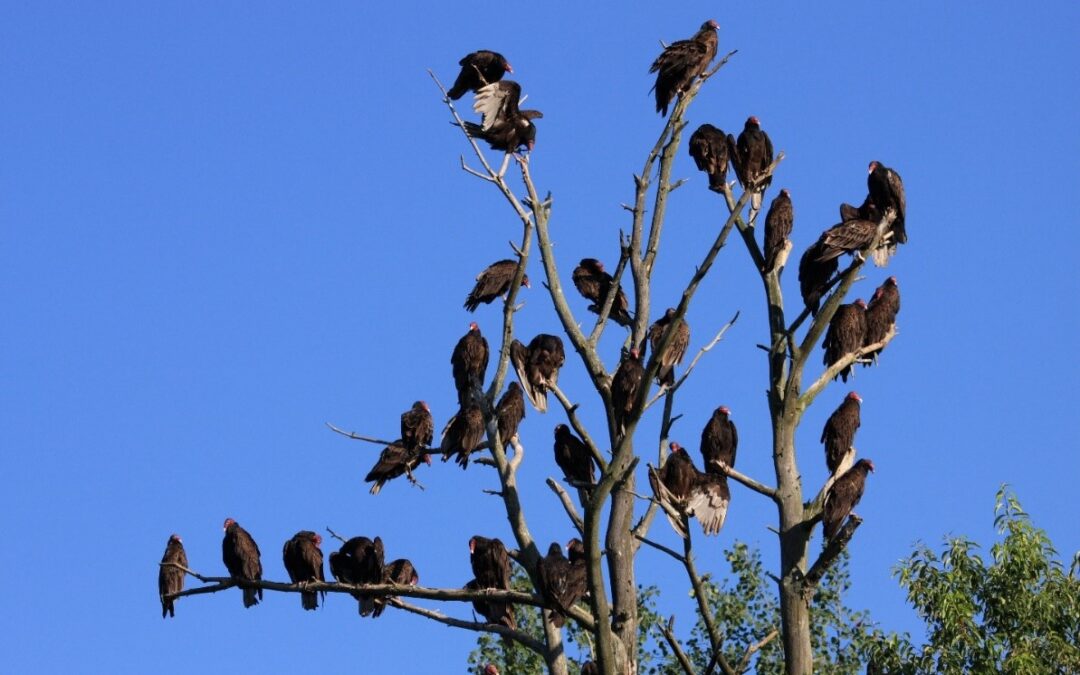By Katie Finch
This time of year, spring comes alive with an array of sounds and colors. I have to smile when I step outside and hear a returning bird call for the first time. I marvel at the fresh green leaves and blooming flowers. So much of what awakens in spring is full of beauty and color. Like old friends returning. It is hard to choose a favorite.
But there is one sign of spring that has a different reputation – the Turkey Vulture. This large bird is generally thought of as unattractive, associated with death and decay. However, it is on the long list of my favorite birds. This early spring migrant has some amazing adaptations and an important role to play in the food chain.
Most of the time, I see Turkey Vultures in flight soaring in circles. This large, dark colored bird they may be mistaken for Bald Eagles, which are a similar size. A Turkey Vulture’s wingspan can be up to 70 inches, while a Bald Eagle is up to 80 inches.
There are some noticeable differences. The most noticeable one is seen head-on. Turkey Vultures hold their wings in a “V” shape, while eagle wings are held flat and even. Turkey Vultures also appear unstable in the air, tilting side to side when they fly. They can fly for hours using the rising hot air with only a few wing beats.

Soaring in the sky, they appear both majestic and ominous. Majestic for their size and flying ability. Ominous for the food they are searching for. Their role in the ecosystem is that of a garbage cleaner. They clean up by eating dead animals. With excellent eyesight and a keen sense of smell (which may be unusual for birds) they scavenge the dead animals in our forests, fields and roadsides. This may sound gross but consider the consequences of not having this clean up role in our ecosystems. The world would pile up with dead animals.
Being scavengers is a somewhat dangerous role, as they encounter a host of bacteria and other microscopic organisms that would make other creatures ill. But Turkey Vultures have a host of adaptions that help them with this “dirty work”.
Noticeable, even from a distance, is the Turkey Vulture’s small, featherless, red head. While contributing to their reputation as ugly, their naked head actually helps keep them healthy. As they feed on dead animals, their head often in the carcass, feathers would hold in bacteria and food particles. Without feathers on their head, they remain a lot cleaner. They also don’t get sick from eating rotten meat. Their strong stomach acid can kill bacteria and even anthrax and influenza.
Other adaptations may also seem disgusting to some. Birds cannot sweat to cool themselves down like humans do. Some open their mouth and pant. Turkey Vultures pee on their legs and feet, relying on evaporation to carry the heat away. It is also thought the urine cleans their legs of bacteria. And when threatened, they projectile vomit on potential predators.

Turkey Vultures can be found in most of North and South America. Because they need their food to be somewhat soft, winter in the northern part of the United States and into Canada is not an ideal time to find food. It would freeze too quickly. Turkey Vultures migrate south to warmer climates in starting in the fall. They can be found year-round in the southern United States and throughout Central and South America. Come spring, Turkey Vultures return north. In our region, they have been seen as early as mid-February- a sure sign spring is on its way.
While Turkey Vultures may not get the award for the most attractive animal, they are an important part of the ecosystems they belong to. Everything has a role, a job, a purpose. In nature, we need the flowers and foul, the beauty and the beast.
Katie Finch is a nature educator at Audubon.
Audubon Community Nature Center builds and nurtures connections between people and nature. ACNC is located just east of Route 62 between Warren and Jamestown. The trails are open from dawn to dusk as is Liberty, the Bald Eagle. The Nature Center is open from 10 a.m. until 4:30 p.m. daily except Sunday when it opens at 1 p.m. More information can be found online at auduboncnc.org or by calling (716) 569-2345.


Recent Comments